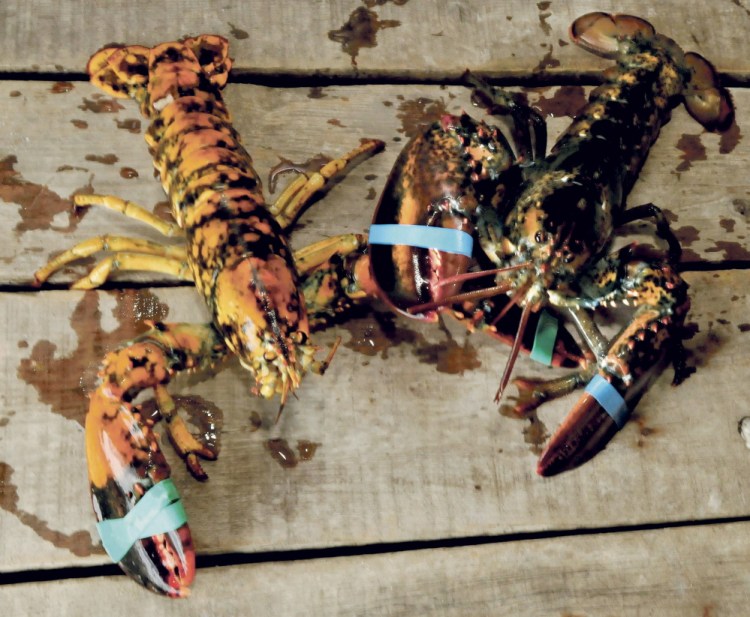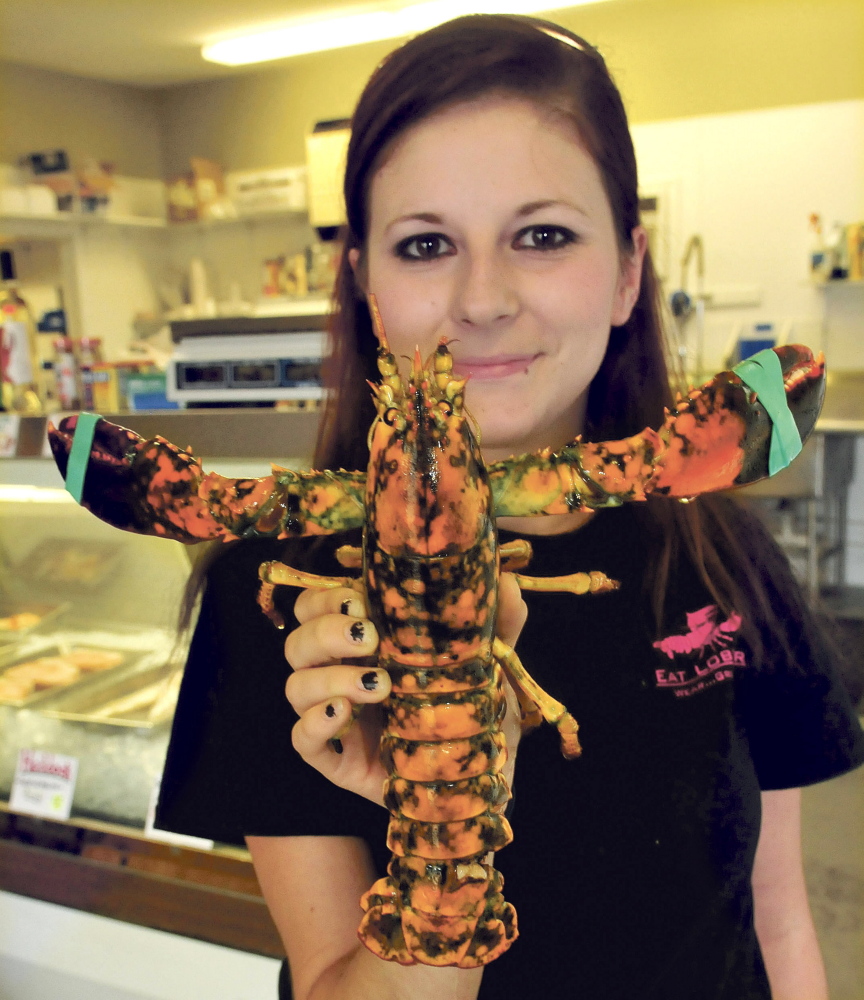SKOWHEGAN — The chances of finding a rare calico lobster in Maine are about one in 30 million, which Chris Foster jokes are also the odds of his favorite baseball team — the Boston Red Sox — making it to the World Series this year.
But earlier this week, Foster, owner of the 201 Market on Madison Avenue in Skowhegan, took his regular delivery of live lobsters, and there it was — a mottled orange, yellow and black lobster called calico because of its distinct coloring.
Foster, who has owned the store since 2010, said he received the lobster in a shipment Tuesday from wholesaler Mark Anderson and his Ocean Land Lobster Co. The rare crustacean was caught in the ocean off Friendship, in Knox County.
“He buys from three or four different lobstermen and that turned up in one of the crates,” Foster said Thursday. “So he gave it to me. He said, ‘Here, I brought you something special.'”
American lobsters are generally dark bluish green to greenish brown, according to the Lobster Institute website at the University of Maine. They’re generally redder on the body and claws and greener on the legs. Lobsters in those colors are plentiful and easy to find, but all lobsters are so commonly colored, according to the institute.
There are vivid blue lobsters, found in only one in 2 million, and there are red lobsters, found in only one of 10 million, according to the institute.
Then there is the calico lobster.
“With only one in 30 million lobsters being yellow, or calico colored, all of a sudden that one in two million blue lobster seems kind of, well, ordinary as far as remarkable coloration in lobsters goes,” according to the Lobster Institute website. “Why? Because once the blue lobster is no longer the rarest lobster on the planet the next rarest lobster becomes even more remarkable. The yellow lobster, with its one in 30 million occurrences, blasts the one in two million occurrences of rare blue lobsters right out of the water.”
Rarer yet is the brown and orange, split-colored lobster and the elusive albino lobster at one in 50 million and one in 100 million finds, respectively, according to Robert C. Bayer, executive director at the Lobster Institute.
But the professor said in an interview Thursday that there is no way to estimate accurately how many oddly colored lobsters are out there waiting to be caught. He said the one in 30 million figure for calicos might need to be recalculated and may not be entirely accurate.
“Most of the numbers you see in these odd-colored lobsters is just somebody’s best guess,” Bayer said. “Nobody really knows. This is not something that’s been studied in any detail.”
Bayer said the calico coloring is not genetic, as is the case in the blue, red and albino lobsters, but rather is the result of some otherwise harmless bacteria in the natural environment.
“Sometimes this color is related to something bacterial under the shell,” Bayer said. “There’s nothing harmful. Most bacteria are not harmful.”
Another calico lobster was found in late August or early September 2014 and brought to market from the Pemaquid Lobster Co-op in Bristol. Still another was caught off Winter Harbor in 2012.
The Associated Press reported in 2012 that it’s becoming increasingly common to hear several stories a month of a lobsterman bringing in lobsters that are bright blue, orange, yellow, calico, white or even split colors. It’s unclear why more odd lobsters are popping up, but the AP reported that it’s likely because the overall harvest has soared, growing fourfold in the past 20 years in Maine to more than 100 million pounds.
As for the calico lobster now on display at 201 Market in Skowhegan, Foster said he hasn’t named it yet and does not intend to sell it — or eat it.
“I just want to keep it for a couple of weeks in my tank so people can come in to see it, because it’s very rare. You’ll probably never see another one,” Foster said, holding the little lobster, which weighs 1.12 pounds. “Then I want to see if I can donate it.”
Foster said he thought about offering the lobster to the Maine State Aquarium in West Boothbay Harbor or the New England Aquarium in Boston.
Meghan Smith, aquarium educator at the Maine State Aquarium, said Thursday that the aquarium has several calico lobsters on display and would welcome another when Foster is ready to donate his.
Send questions/comments to the editors.





Success. Please wait for the page to reload. If the page does not reload within 5 seconds, please refresh the page.
Enter your email and password to access comments.
Hi, to comment on stories you must . This profile is in addition to your subscription and website login.
Already have a commenting profile? .
Invalid username/password.
Please check your email to confirm and complete your registration.
Only subscribers are eligible to post comments. Please subscribe or login first for digital access. Here’s why.
Use the form below to reset your password. When you've submitted your account email, we will send an email with a reset code.